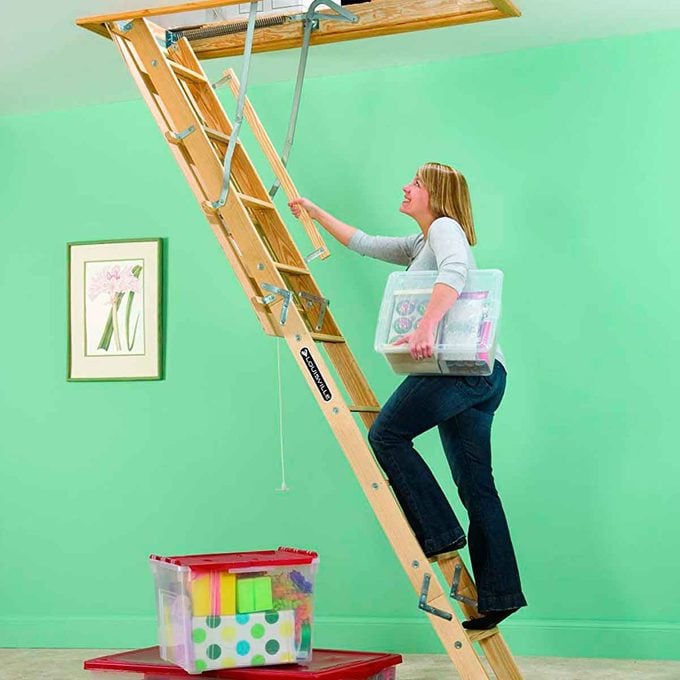What to Know About Attic Ladders
Updated: Dec. 01, 2021
Do you have unused storage space in your attic? Install an attic ladder to reclaim it.

You have all that storage space in your attic, but lifting boxes through that rough-hewn hole in the ceiling can be difficult, and dangerous, from a step ladder. It’s time to reclaim that unused area and install an attic ladder.
An attic ladder is sometimes called an attic stair. It is essentially a ladder that sits in a frame in the ceiling and pulls down to allow access to the attic. Here are a few things to remember before buying and installing an attic ladder:
Location Matters
Your new attic ladder needs to fit between the existing joists in your ceiling or in an old attic access spot. Most attic ladders need approximately a 22-1/2- in. x 54-in. opening, but compact kits are available to fit tighter spaces. Choose a spot that allows you to safely step on and off the bottom and top rungs while carrying boxes or bags.
These are the 10 important things you need to do if you decide to finish your attic.
Measure Twice
After you’ve found the right location, measure the distance from the ceiling to the floor. Attic ladders are available in different lengths, and you want the bottom of the “stringers” (ladder rails) to fully extend and touch the floor. If the stringers end up being too long, they can usually be trimmed to fit. Also, check the height of the attic space to make sure there is enough room for the ladder to fold or slide freely into the space.
Measure the top and bottom of the framed opening, using the smallest of the measurements as your guide. You should also check the load limit on the attic ladder kit to make sure it will be safe for family members to climb up and down the ladder with the added weight of storage boxes.
Learn how to save energy with DIY blown-in attic insulation
What’s Your Type?
Attic ladders fold, telescope, scissor or slide up into the attic space. Some have electric motors. Attic ladders are often made of wood, but some are made of aluminum or steel.
Consider whether you’d prefer to hold on to a handrail as you carry items up and down the attic ladder, or use the upper rung for support. The National Safety Council (NSC) advises three points of contact with any ladder at all times.
Attic ladders have either traditional rungs or shallow steps. The angle of an extended attic ladder may differ as well, but it is usually steeper than a regular staircase.
Prices range from less than $150 to more than $1,500, depending on load limit, material, quality of construction, length and the size of the opening.
If you’re in the market for an all-purpose step ladder, check out this video about one of our favorites.
Take Steps
Hiring an installer could cost equal to or more than the cost of the attic ladder itself. DIYers with moderate experience can complete this installation by following the instructions that come with the kit. Whether you do the installation or someone else does it for you, be sure to inspect the finished project before anyone uses the ladder. Look for unwanted gaps, missing or loose fasteners, or broken or cracked parts. Fix any problems before letting anyone make the inaugural climb into the attic.
Make sure your attic ladder door closes tightly and has weather stripping to reduce heat loss. You could add weather stripping or an insulated cover box after you have installed the kit.
